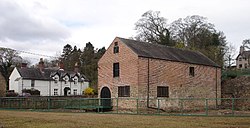This article needs additional citations for verification .(April 2025) |
| River Clywedog | |
|---|---|
 The Clywedog near Bersham | |
 | |
| Etymology | Prob. derived from Welsh clywed, "to hear", clywedog meaning "noisy" |
| Native name | Afon Clywedog (Welsh) |
| Location | |
| Sovereign state | United Kingdom |
| Country | Wales |
| Principal area | Wrexham County Borough |
| Nearest city | Wrexham |
| Physical characteristics | |
| Source | |
| • location | near Gwynfryn, Wrexham County Borough |
| • coordinates | 53°3′46.078″N3°6′20.527″W / 53.06279944°N 3.10570194°W |
| • elevation | 320 m (1,050 ft) |
| Mouth | |
• location | confluence with River Dee, near Sutton, Isycoed, Wrexham County Borough |
• coordinates | 53°1′10.985″N2°52′56.905″W / 53.01971806°N 2.88247361°W |
• elevation | 14 m (46 ft) |
| Basin features | |
| Tributaries | |
| • left | Gwenfro |
The River Clywedog is a river in Wrexham County Borough, Wales. [1] Its uses have been watering crops, powering industrial machinery but is now used as walking trails or geography trips. [2] The river originates to the west of Wrexham, and joins the River Dee some four miles south east of the city.


